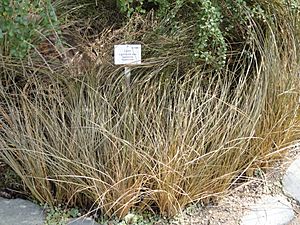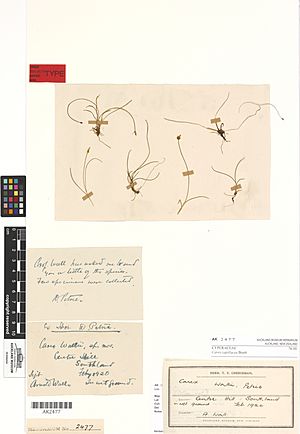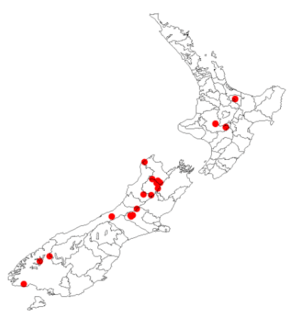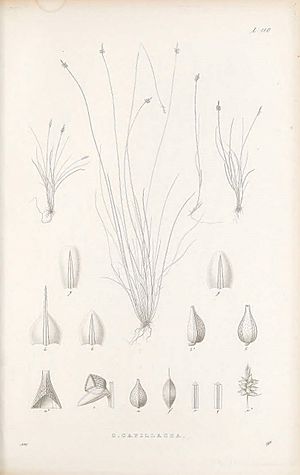Carex capillacea facts for kids
Quick facts for kids Carex capillacea |
|
|---|---|
 |
|
| Carex capillacea | |
 |
|
| Isolectotype: AM AK2477-1 | |
| Conservation status | |
 Nationally Vulnerable (NZ TCS) |
|
| Scientific classification | |
| Genus: |
Carex
|
| Species: |
capillacea
|
 |
|
| Occurrence data from AVH | |
Carex capillacea, also known as the yellowleaf sedge, is a type of grass-like plant called a sedge. It belongs to the Cyperaceae family. You can find this plant in many places around the world. It grows in parts of Asia like Assam, China, Japan, and India. It's also found in New Guinea, Malesia, and countries like Australia and New Zealand.
What It Looks Like
This plant grows in thick clumps. Its stems, called culms, stand straight up. They can be up to 30 centimeters (about 12 inches) tall. These stems are quite thin, like a piece of string.
The leaves of the yellowleaf sedge are usually shorter than its stems. The bottom part of the leaf, called the sheath, can be green or light brown.
The plant has an upright flower cluster called an inflorescence. This cluster has one main spike. The male parts of the spike are found above the female parts. The plant's style, which helps with reproduction, is divided into three sections.
Carex capillacea flowers from October to December. It produces fruits from October to July. The tiny nuts inside these fruits are spread in two ways. They can be eaten by animals, which then spread the seeds. The wind also helps to carry the seeds to new places.
Where It Grows
The yellowleaf sedge lives in many different parts of the world. In New Zealand, you can find it on the North Island. It grows in areas like the Waimarino Plain and near Moawhango.
On the South Island of New Zealand, it grows from Nelson and Marlborough. It can be found south to the lakes of Te Anau, Manapouri, and Hauroko. It also grows east towards Lumsden.
This plant likes wet places. It often grows in bogs, which are wet, spongy areas. You can also find it where water seeps out of the ground. It likes the edges of ponds and pools too.
How It's Protected
Experts check the conservation status of plants to see if they are in danger. In New Zealand, this is done using the New Zealand Threat Classification System (NZTCS).
In 2013, Carex capillacea was listed as "At Risk – Naturally Uncommon." This means it's not found in many places naturally. Later, in 2017, its status changed. It was then listed as "Threatened – Nationally Vulnerable." This means it is more at risk. In Tasmania, Australia, it is also listed as "Threatened."
About Its Name
The plant Carex capillacea was first described in 1858. A scientist named Francis Boott gave it its name. He studied samples collected in the Himalayan mountains. These samples were found by Joseph Dalton Hooker in Sikkim and by William Griffith in Bhutan. They were found at very high altitudes, between 10,000 and 12,000 feet (about 3,000 to 3,600 meters).
The second part of its name, capillacea, comes from a Latin word. The Latin word capillus means "hair" or "thread." So, the name describes the plant as looking thin and thread-like.


